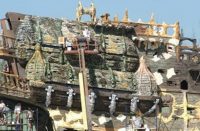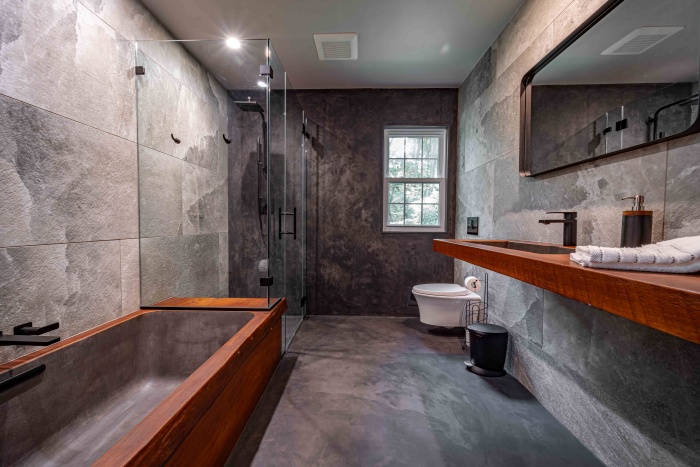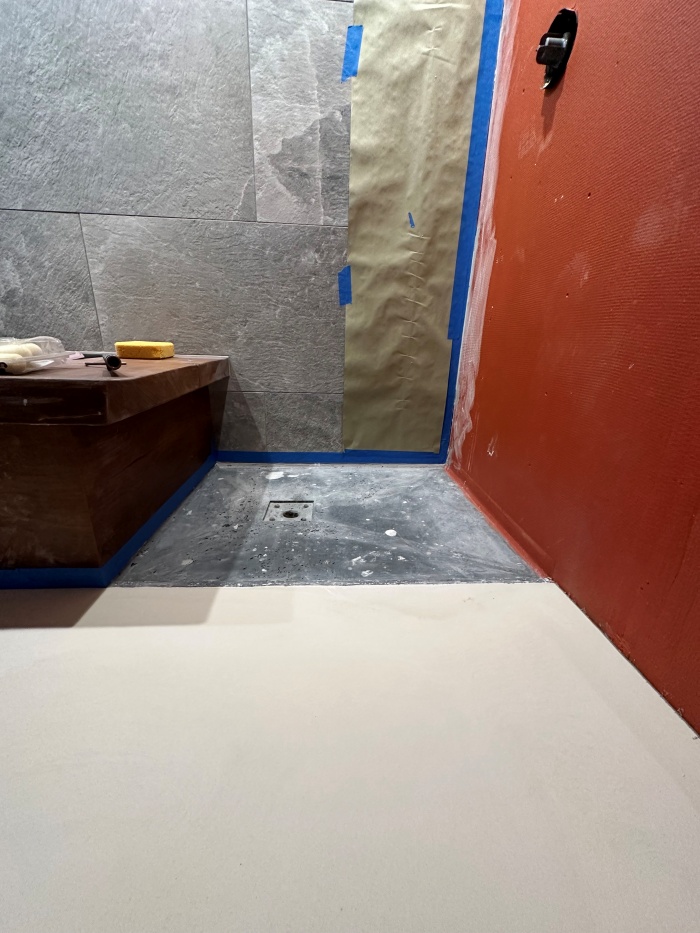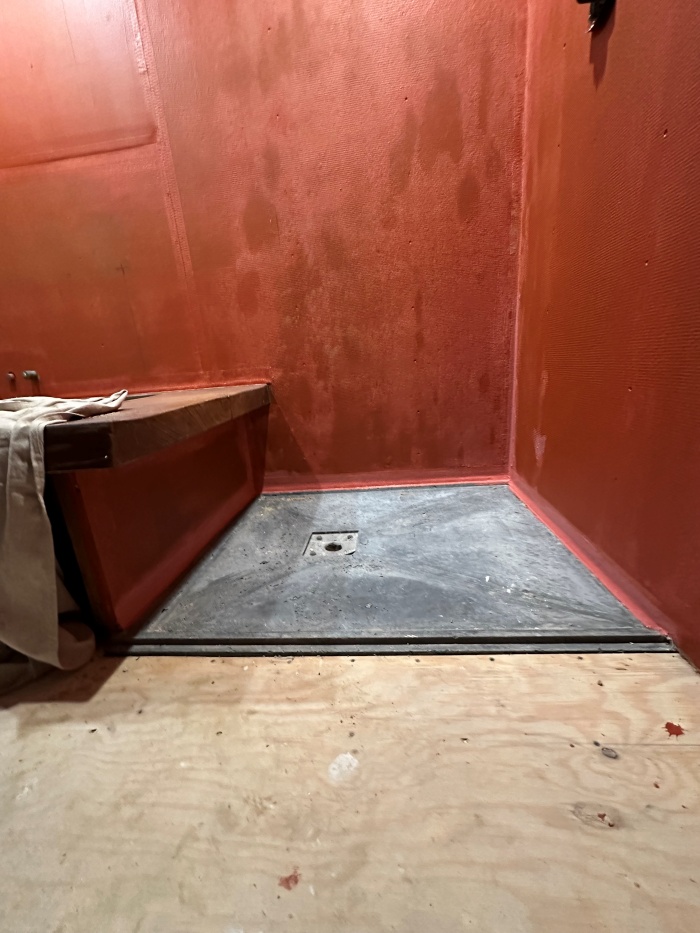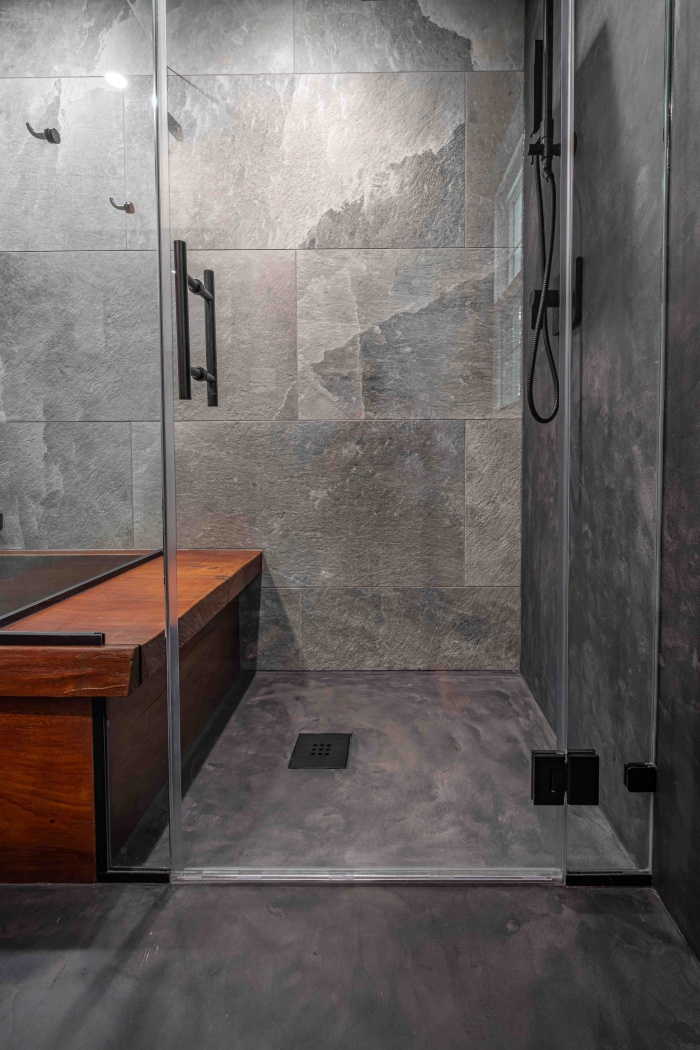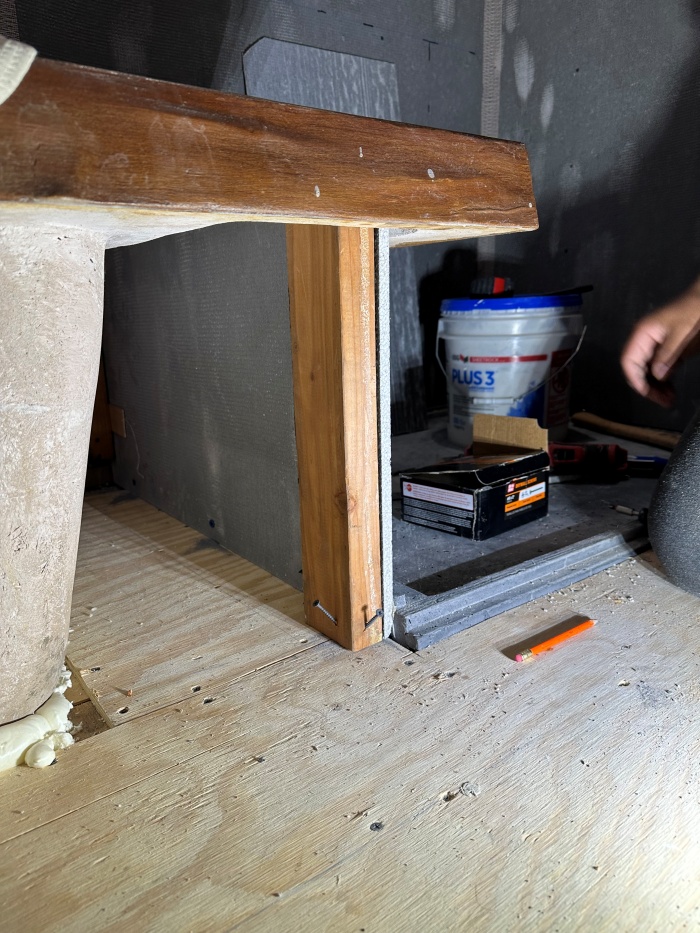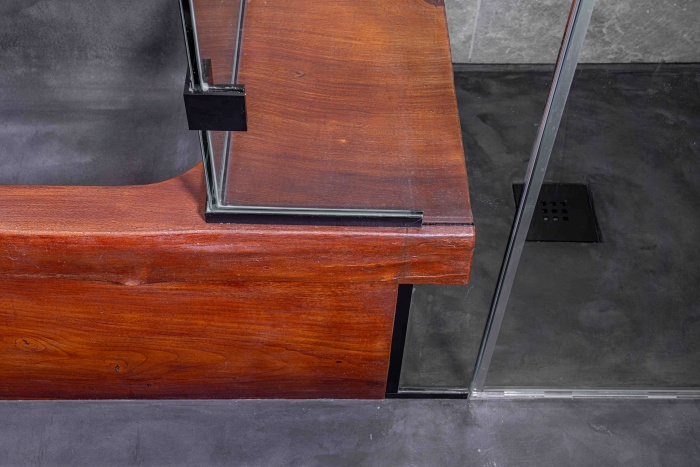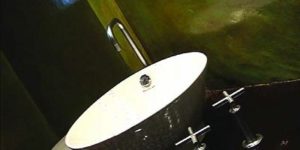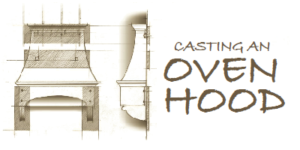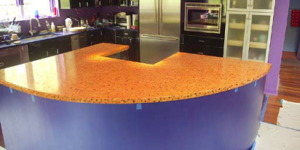Jeff Kudrick, concrete artisan extraordinaire and founder of the New Jersey decorative precast company JM Lifestyles LLC, had long wanted to create a concrete “oasis” in his own home. His vision: A seamless concrete floor-to-wall surround that would be continuous in an integration of shower, walls and floor. A key to turning this vision into reality would be the use of MgO board and his creation called WoodForm Concrete.
But he faced a major challenge in cobbling together existing building materials for backer boards, walls and floors, and somehow making it all work in tandem, effectively. Among other issues, his reconstruction would need to remain intact and unblemished by tectonic forces de minimus, as the ancient Romans would call it – the inevitable, natural though minor movement of the wood framing of his New Jersey home.
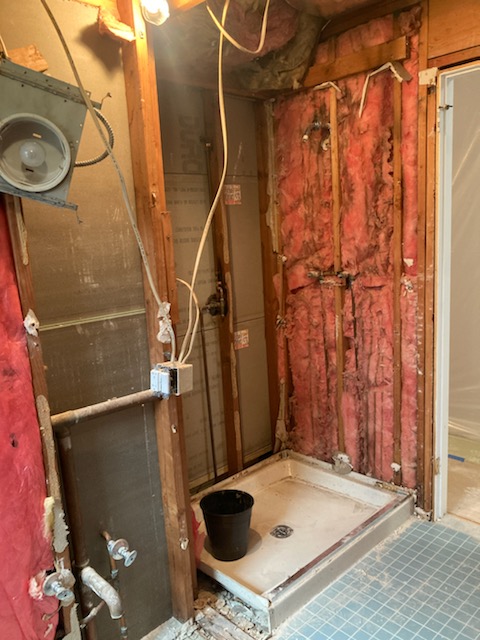 |
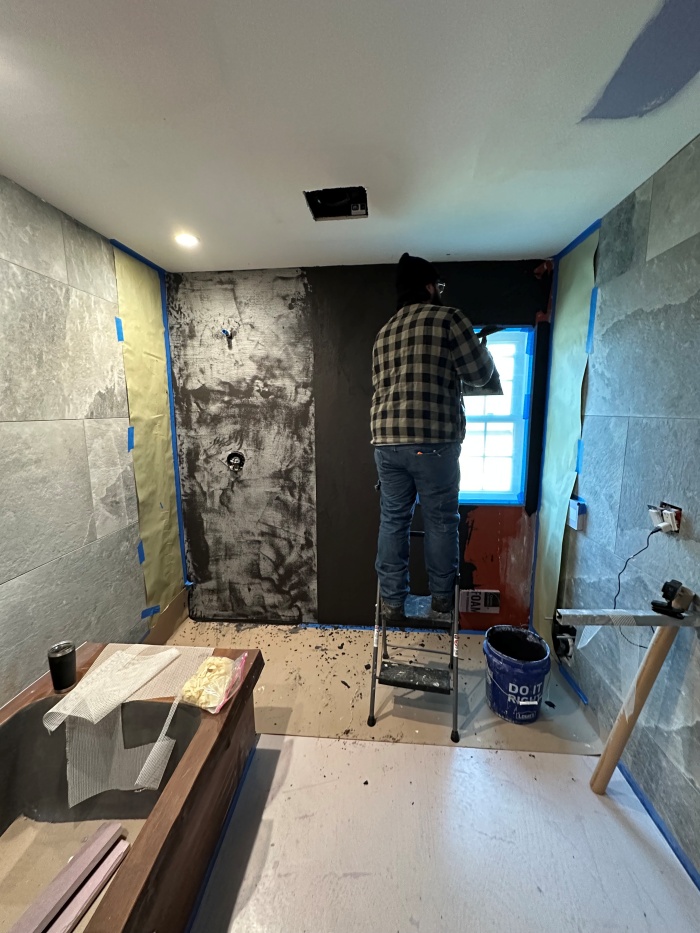 |
Right: Jeff Kudrick installed and coated MgO board as part of his residential bathroom remodel. |
|
Breaking Free of the Old Bathroom Design
The existing bathroom construction consisted of mud floor over plywood, topped by blue pastel tiles. Other elements were bathtub, two vanities and an alcove shower.
Kudrick’s plan was to eliminate the alcove and use that space in a future master-bedroom renovation. He planned the shower and tub in line on one wall and planned a floating vanity to go on the opposite wall. Installation of a Kohler wall-mount toilet would help retain the clean, seamless and open floor look.
The project and its performance demands, he thought, represented a good candidate for the use of a relatively new building-material technology: magnesium oxide, or MgO, board. He had learned of the material from a friend, and started experimenting with it.
“I was impressed with the properties and decided this board could be the answer I’d been searching for to be able to apply the finishes I wanted, with assurance of their resilience and looking great years from now, crack free,” he says in recounting how his plans evolved.
A key concern, however, was the reliability of a material that remained a relative newcomer to the trade in these parts. Elsewhere, mostly overseas, it has compiled an impressive track record as a high-performance material well suited to demanding settings where moisture and structural movement present major challenges to long-term efficacy of building components.
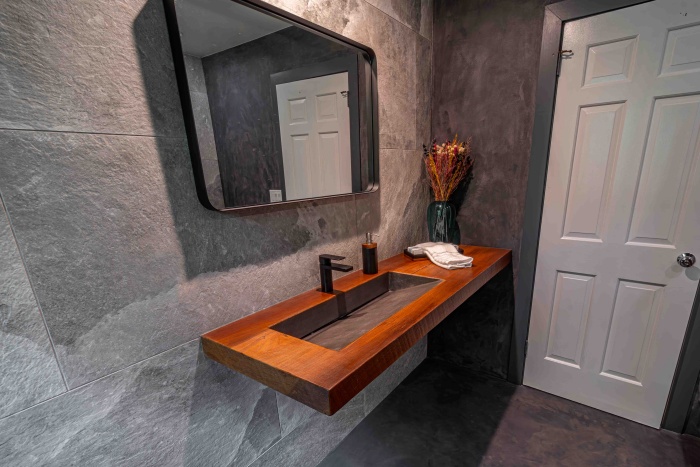
Enter MgO Board
The high-performance material in question in the case of Kudrick’s ambitious plans was a particular magnesium oxide (MgO) board. He found this product through searching and reading case studies and specifications, and tested it on his own to confirm the high level of performance indicated. It’s a high-strength building product described by the manufacturer in this case as a “new-age smooth-faced multi-purpose construction board for use in applications requiring a combination of moisture and thermal resistance and superior performance in fire.”
For Kudrick’s project, the MgO board product used is Cem-Rock Extreme x4, offered by Greenspan USA LLC, a business unit of Greenspan System Sales Ireland Ltd. The material is described as an alternative to fiber-cement board in settings where greater dimensional stability is needed.
Greenspan, based in Limerick, Ireland, calls the MgO board “an ideal substrate” for exterior walls, interior partitions, tile backing for wet and humid areas, floor underlayment, fire-rated core for doors, interior and exterior ceiling,soffit, structural insulated panels, and exterior finishing systems.
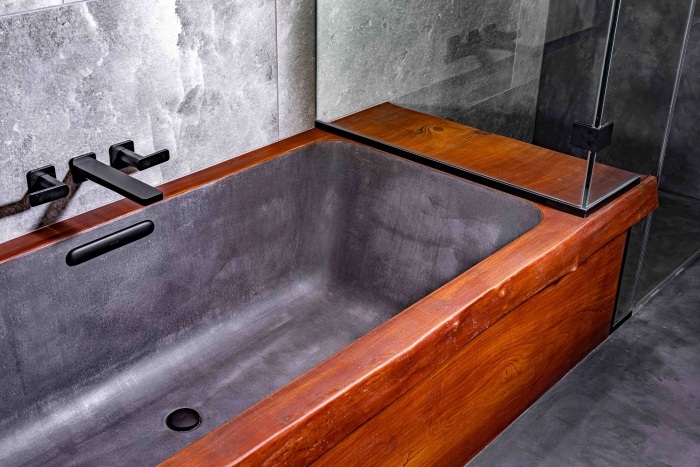
Benefits of MgO Boards
MgO boards are produced with a combination of magnesium oxide – a naturally occurring mineral cement – and oxygen, a combination that produces high strength when processed. Unlike typical gypsum drywall, MgO boards are not paper faced, and are offered in varied surface types including smooth faced, rough texture, utility, and versatile. Besides high strength, MgO boards are widely specified for applications requiring fire resistance and water and moisture resistance, and are “non-nutritious” (resistant) to fungus, mold, mildew, and insects.
In the field, MgO boards are handled and installed like other materials used for wall, floor and trim. They require no specialized tools for sawing, drilling, scoring, and fastening to wood or steel framing.
Magnesium cement is produced in various regions worldwide, primarily in locations near magnesia ore deposits. Sources in the United States are described as minimal, but consumption of MgO board is accelerating in the U.S. nonetheless, particularly in coastal areas.
Assembling a Monolithic Space
“The challenge was to apply a concrete finish having the same look on the floor, up the two opposing walls and into the shower, seamlessly, with no curbs,” he says.
Here, Kudrick called on his precast experience to cast a shower pan complete with tile ledges and integral drain transition.
The shower wall, positioned inside the exterior wall of the house, needed to be recessed from the outer wall to accommodate an air gap and insulation, a necessity in the volatile New Jersey climate. Kudrick gave the two side walls of the bathroom a kind of “spa” look using 2-by-4-foot tiles with a “rock salt” finish, imparting a “salt cave” impression to the space. The side walls of tile framed the concrete finish separating the two walls.
Anticipation problem areas
A potential problem area was the intersection of a portion of wall substrate and shower pan surface. Any type of board used for the wall substrate – and dropping inside the pan in front of the tile ledge – would inevitably be subject to moisture intrusion and potential degradation and breakdown.
“Typical masonry boards are not very strong, they wick water due to their porosity or break down and may even grow mold, and they may also deform due to the moisture,” Kudrick says. In addition, the typical size available may be only 3 by 5 feet.
The wall where the vanity was placed was a combination of standard sheetrock and MgO board, with an elastomeric membrane – ElastoShield from Surecrete – applied to all of the walls. The product used prevents water in the floor overlay from being absorbed into the substrate(s) and unevenly drying and making it difficult to finish the surface of the overlay evenly. Additionally, where thin-set mortar was used the same principle is applied, by providing open time to adjust the placement of large-format tiles.
Surecrete Design Products’ elastomeric membrane and reinforcement scrim were also applied at the wall-shower-pan seam, providing an additional protective barrier at this crucial junction.
The MgO board’s strength and durability provide an effective substrate that enhances the performance of the finishes used on the floor and walls, Kudrick says.
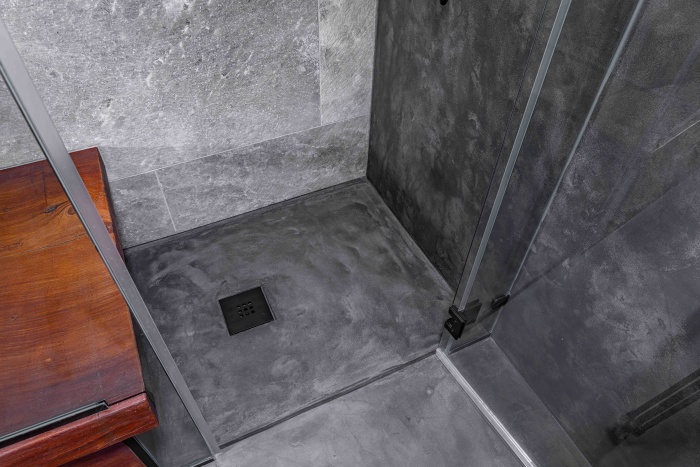
Completing the Oasis
Kudrick completed his spa-oasis with a custom-molded tub cast by JM Lifestyles, using his own WoodForm mold. He cast the tub ledge with a live edge. He made the top of the ledge continue into the shower to provide a seat inside.
Then, he used another WoodForm mold to integrally cast the vanity top with a rough-sawn edge.
For Kudrick, the MGO board fit perfectly with the other pieces of the puzzle. Together, the transformation of the bathroom space came together exactly how he envisioned. He chose MgO board because of “the large size of the board and its stability and strength.” This combination mitigates movement in a wood- or steel-framed structure.
The smooth #5 finish on the board face “also allows for a variety of finish options for shower surrounds,” he says. He even offered one such potential concept – a metallic epoxy prefinish and setting the board as if it’s an oversize tile.
“The options are endless,” he says.
Making the Case for MgO
In a Q and A conversation, Kudrick expands on his experience with MgO board technology and what it brings to the decorative and architectural-concrete trade. He based this on his use of this relatively novel material in the North American marketplace. Some excerpts from the conversation follow.
Q. What would you say are the strengths/advantages from your experience using Cem-Rock versus other types of cement board or wood panel type products?
A. When it comes to MgO boards the devil is in the details. The span ratings, the fire assembly performance and the strength in application makes Cem-Rock a solid choice. The product’s formulation and characteristics make it well suited to practical uses and methods. Additionally, the product’s track record in Europe provides ample evidence of this.
Q. What are its advantages when used in a shower-type enclosure like the project you describe here in your own home?
A. The material is full size, 4 by 8, so seams are fewer as opposed to 3 x 5 board. The pull-out strength is formidable, so there’s no need to back up the boards with plywood for shower bars or other attachments. For niches, simply cut glue, nail, and create the shapes you desire. You can then apply waterproofing over a stable substrate that will hold up. For a shower pan, a precast plan is ideal. A foam type construction method such as a Schluter will work, but you will need a thick fiber-reinforced overlay applied to build up a heavily reinforced base layer to distribute the point loads on foam.
Q. What types of fasteners should you use to attrach Cem-Rock to wood or metal studs or ICF (insulated concrete forms)?
A. You can use either stainless screws, or exterior coated screws with a flat head and ribbed neck. Be sure to install these screws flush to the MgO board surface. You can also use a modified thinset mortar for ICF to set the board like a tile. You can prefinish the Cem-Rock MgO boards, for example, with a metallic epoxy, and then set the board on the wall with the look of an oversized tile.
Q. Which thickness do you recommend for a shower enclosure? What about the floor inside/outside the shower?
A. The 1/2-inch Extreme board is amazingly strong. It is useful for almost every application, especially when adhering pull bars to the wall and not requiring backing. The lightweight board is very durable and easily installed, and as an underlayment it won’t have the same screw-pullout tendency and require blocking. The 3/4-inch board on the floor and tile right over it is a slam dunk. There are important details and methods to installing it effectively, but it’s far easier and faster than applying plywood and gluing and screwing Durock to the floor.
Q. What kind of construction finishes can you apply to Cem-Rock (ceramic tiles, cement toppings, etc.)?
A. We have been putting everything on it. I have a high-end bathroom where we laminated fiberglass sheets to it. Concrete overlays, metallic epoxies, tile, stone sheets, you name it, all are possible.
Q. How should you treat the joints (ends of each board) to mitigate moisture movement to the framing side of the wall surface?
A. I typically use a Bostik adhesive for the board-to-board connections and then a waterproofing membrane with seam reinforcement. The #5 finish side takes adhesives and even the concrete finishes without bonding issues.
Q. What must you do to transition from Cem-Rock to sheet rock or other types of wall systems?
A. Nothing, if you are going to use sheetrock. Just tape and apply compound.
Q. Does this material expand or contract with changes in temperature? Exposure to moisture?
A. The specifications indicate very little movement in either temperature swings or moisture. I have assemblies with glued seams and overlays on top that have shown no effects of the New Jersey winter. It’s the joints that matter and I am continuously testing these details. Hopefully we will revisit the status in another project review, and update any result.
Q. How do you cut this MgO board in the field?
A. Either carbide blades or diamond blades will do the job, as there is no heavy aggregate. Additionally, the use of jig saw or reciprocating or oscillating blades are great options as well. I’ve also used flap-wheel sander discs and carbide routers to shape it, with some very interesting results.


